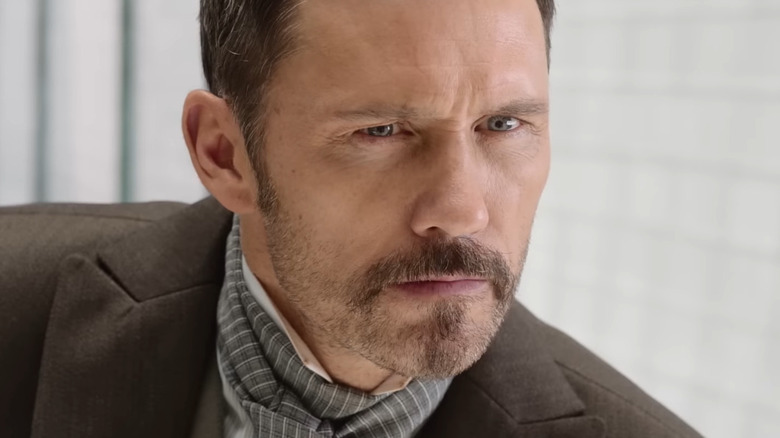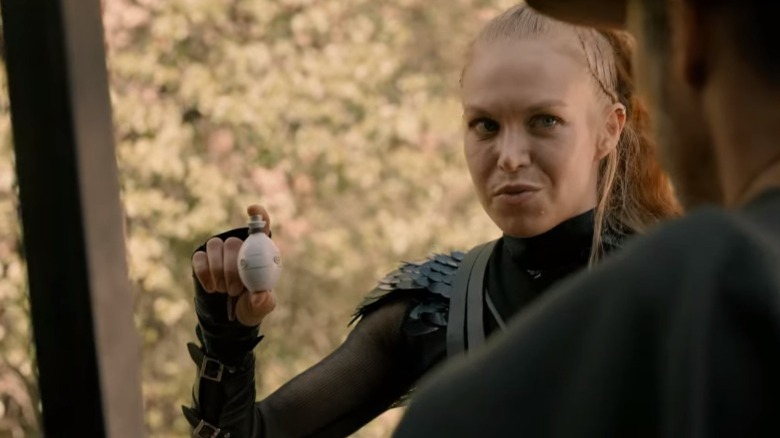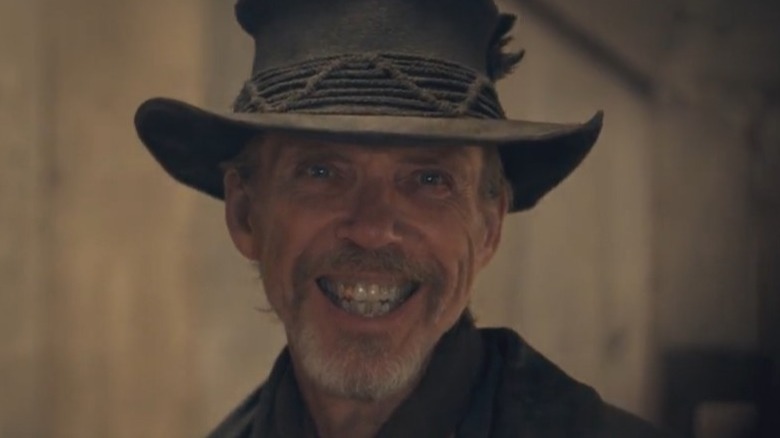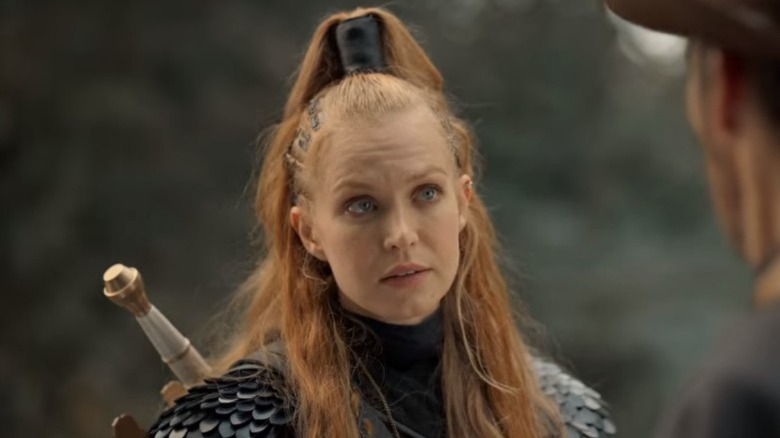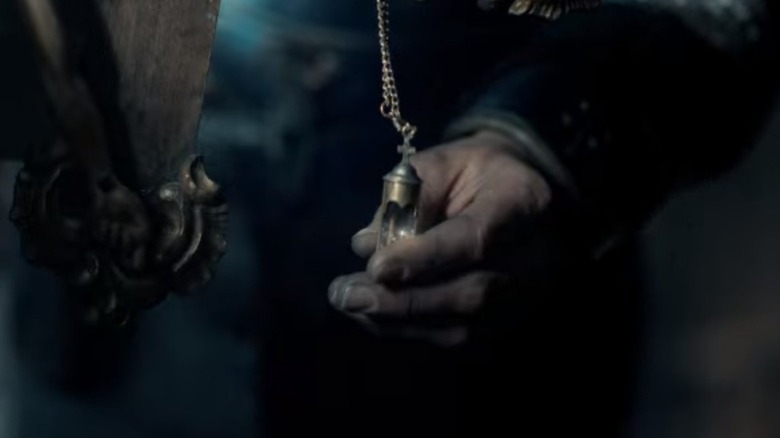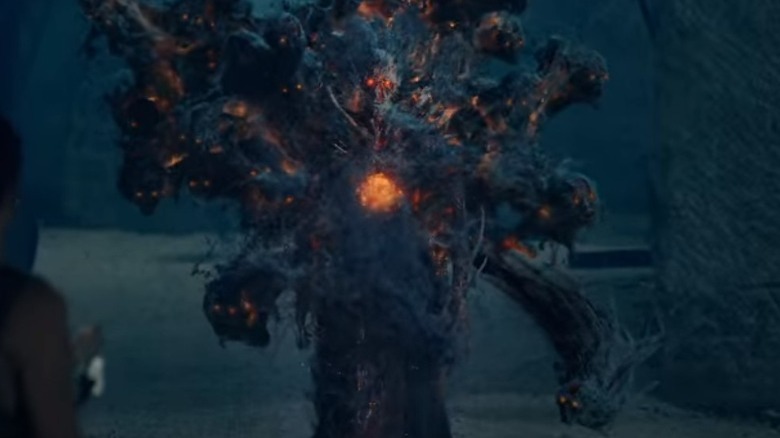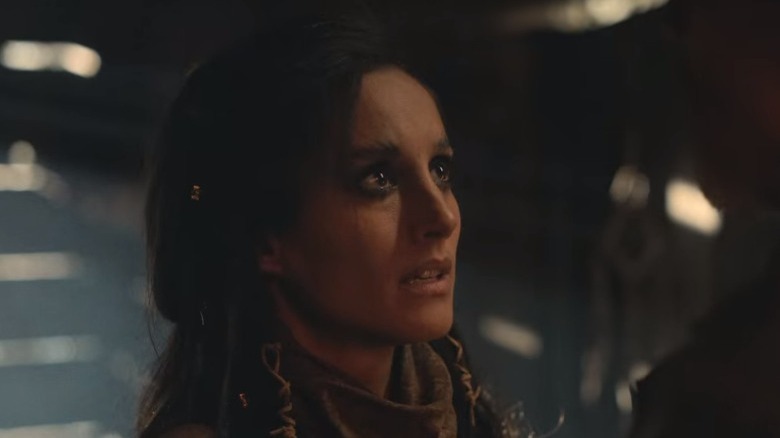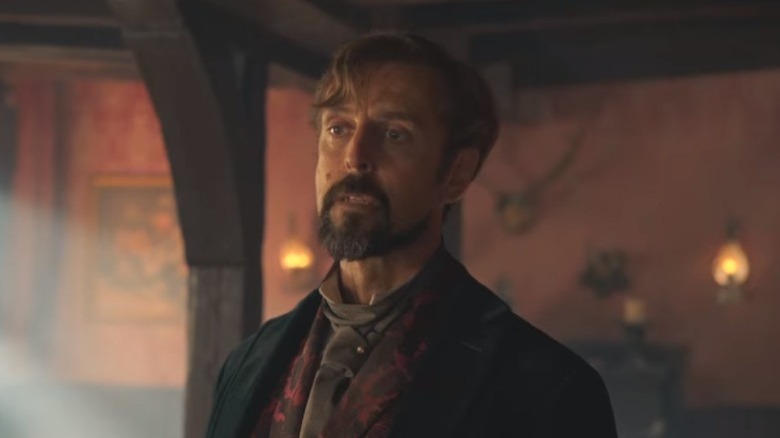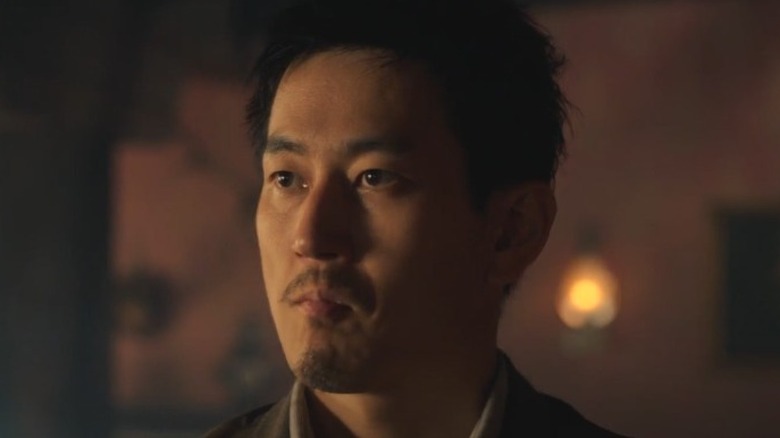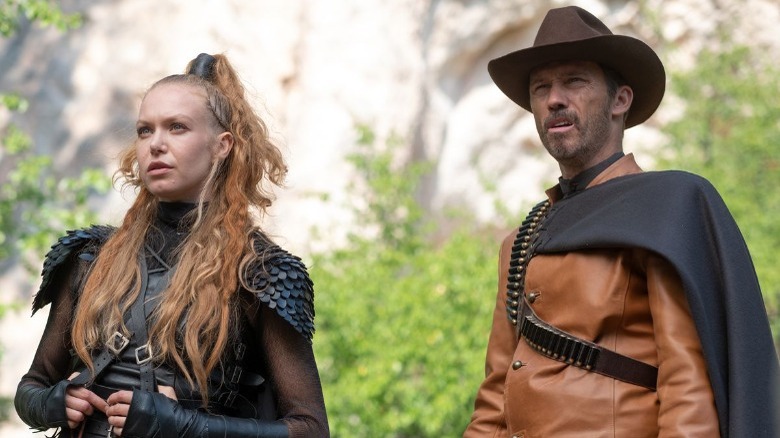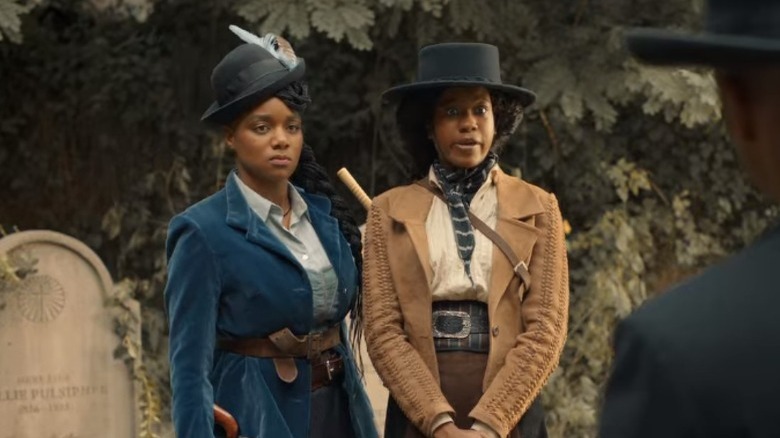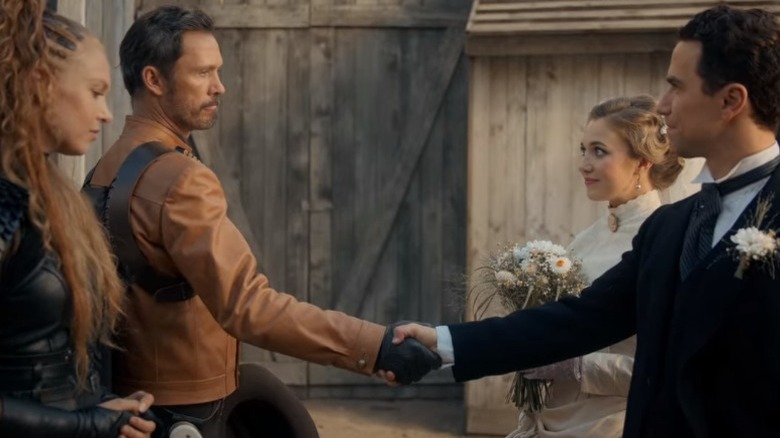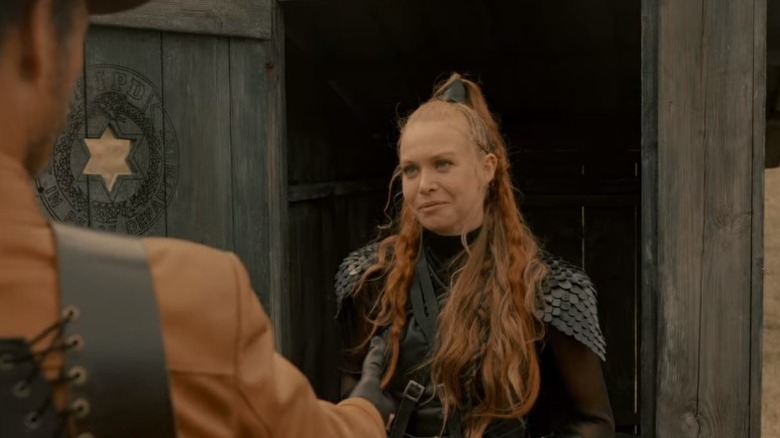The Ending Of R.I.P.D. 2: Rise Of The Damned Explained
Like an undead soul who narrowly escapes Hell, we've been unexpectedly gifted with a prequel to Ryan Reynolds' second-worst movie in "R.I.P.D. 2: Rise of the Damned." Although critics savaged the original "R.I.P.D.", which hit theaters in 2013, its middling IMDb rating indicates audiences appreciate it for what it is: An entertaining re-tread of "Men in Black" with undead souls instead of aliens, and an excuse for Jeff Bridges to dust off his "True Grit" accent. Despite how badly the original bombed at the box office, the powers that be resurrected the franchise nearly a decade later for another undead tussle.
Despite the "2" in the title, "R.I.P.D. 2: Rise of the Damned" takes place more than a century before "R.I.P.D." in the year 1876. This movie chronicles the death and initial R.I.P.D. service of Roy Pulsipher, here played by Jeffrey Donovan. He's mentored by a mysterious warrior named Jeanne (Penelope Mitchell) who teaches him how to corral renegade dead souls, aka deados. With the same self-aware humor of the original, "R.I.P.D. 2: Rise of the Damned" goes through the invitingly familiar beats of a buddy cop story — this time with the trappings of the Old West and the supernatural. It all culminates in a explosive finale. You'll be on the edge of your seat — but you might also be a little confused by all the afterlife shenanigans. We're here to help you unravel them. This is the ending of "R.I.P.D. 2: Rise of the Damned" explained.
Deados, possession, and undead armies
Tacitly admitting that the original "R.I.P.D." isn't a culturally ubiquitous touchstone (in fact, it was one of the most expensive flops in movie history), "R.I.P.D. 2: Rise of the Damned" takes the time to establish its metaphysical rules by seeing Roy learn all about being an afterlife cop upon his untimely death. Roy and Jeanne, as R.I.P.D. officers, can walk in the living world, but they don't look like themselves as they do it. Moreover, they can't interact with any of their loved ones. This is all present in the 2013 movie, but the prequel throws a new wrinkle into the situation: Here, deados can escape into the mortal realm.
In the original movie, the deados are essentially chaotic ghosts who can pose as regular humans. But in "R.I.P.D. 2: Rise of the Damned," dead souls must possess living bodies after escaping Hell. It's specifically explained that the Samuels brothers — apparent outlaws who ambush Roy and his family at a train station — were actually law-abiding citizens, until they were possessed by undead souls. This adds a new level of urgency to Roy and Jeanne's mission to close the portal to Hell that's set to open in Red Creek, Utah: A mysterious deado who's taken over the body of a man named Otis (Richard Brake) has kidnapped multiple humans, in order to have them possessed by an army of the undead.
Hell on Earth
As main villain Otis cryptically explains, he's grown tired of grappling for supremacy in Hell. Thus, he fled the infernal pit during an eclipse and fomented the evil plan he's now putting into action. Otis is looking to kidnap enough humans to dig a portal to Hell during the next blood moon. He and his goons even helpfully provide masks for the kidnapped citizens of Red Creek, so that they might avoid dying from the sulfuric fumes of Hell. Why does he need humans to dig the portal, you ask? Because, as is the case in many vampire stories, dead souls need to be "invited" to the Earthly realm by the living themselves.
Conveniently, this rule provides the dead souls with host bodies to take over when they swarm up from below the ground. There's a catch, though, which Angus (Richard Fleeshman) figures out: They can't possess you if you close your eyes. As viewers might have guessed from the fact that Earth isn't a literal Hellscape in the 2013 world of "R.I.P.D.", Roy and Jeanne arrive in the nick of time to foil Otis' plan and seal the portal once more.
Jeanne, Jean, or Joan?
"R.I.P.D. 2: Rise of the Damned" isn't the kind of movie that requires the viewer to think terribly hard about anything. So it's actually kind of a fun surprise when Jeanne turns out to be none other than the legendary Joan of Arc. In retrospect, the movie makes this fact more than a little obvious by way of Jeanne's general demeanor, French accent, religious devotion, and a reference to her service in the R.I.P.D. spanning 445 years — a figure that works perfectly with Joan of Arc's 1431 burning at the stake. But rather than just throwing in this detail for fun, a la Joan of Arc's glorified cameo in "Bill and Ted's Excellent Adventure," "R.I.P.D. 2: Rise of the Damned" incorporates Joan's past into her character arc.
At multiple points, Jeanne is visibly uncomfortable with fire. Late in the film, she admits that she's been haunted by her own dying screams for the better part of five centuries. After a pep talk from Roy — "You've got a fire in you greater than anything that ever came out of Hell!" he insists — she finds the will to leap over the fire-spewing portal to the underworld and seal it shut. After leading a revolution and spending centuries hunting dead souls, Joan of Arc still has a little bit to learn from a cranky American sherriff.
Tears ex machina
With her identity as Joan of Arc laid bare, Jeanne also reveals — quite late in the game, in must be said — that she possesses an important artifact: the Tears of Christ. Like many other cinematic holy relics (recall the "Indiana Jones" franchise), the Tears turn out to have a sort of cure-all effect. Not only do a few drops seal the portal to Hell in jiffy, there are just enough left over for Roy to lace a bullet and take down Otis once and for all. It's certainly lucky that in her 445 years of battling undead souls, Jeanne has always had enough holy water (and R.I.P.D. weapons) to neutralize threats.
"R.I.P.D. 2: Rise of the Damned" explains the presence of the Tears in an off-hand way that raises even more questions. Jeanne says that she took a breather during the siege of Orleans in 1429 and found the Tears dangling from a sword in the wreckage of a church. The chain of custody from Jesus Christ himself to a random Orleans parish a millennia-and-a-half later isn't discussed, nor is it explained how undead R.I.P.D. officer Jeanne got them back, after her mortal form perished. No matter how cherished your possessions, you can't take them with you — unless you're Joan of Arc, apparently.
Astaroth, one third of the evil trinity
Late in "R.I.P.D. 2: Rise of the Damned," main villain Otis reveals he's no ordinary undead soul — he is, in fact, Astaroth, one third of the evil trinity that has ruled over Hell for years. Unless you're a serious expert in demonology or Judaic lore, you might find yourself wondering who the heck this guy is. Astaroth is a relatively obscure figure, especially compared to his co-rulers. Lucifer hogs most of the public's attention in everything from epic poetry like "Paradise Lost" to all six seasons of the TV series "Lucifer." Beelzebub claims a smaller sliver of spotlight, but he at least gets minor parts in stories like "Good Omens" and shout-outs in Queen songs like "Bohemian Rhapsody." Astaroth, in contrast, rarely appears in pop culture — until now.
The demon has tired of sharing power, and nearly succeeds in creating his own dominion of the undead to rule over on Earth. Embarrassingly, however, he spends the movie mostly reliant on stolen R.I.P.D. technology to intimidate his minions, and gets blasted out of existence by Roy, who mockingly refers to him as "A**hole-roth." Despite being a member of the first triumvirate that rules over Hell, Astaroth still can't get any respect.
A rogue R.I.P.D. officer
Tantalizingly, "R.I.P.D. 2: Rise of the Damned" introduces a rogue R.I.P.D. officer in the character of Nell Boyce (Nóra Trokán), who has betrayed the forces of good and become chief lieutenant to Otis, aka Astaroth. She's clearly very devoted to the idea of Hell on Earth, making one wonder how the recruitment department that Jeanne mentions could have been so spectacularly wrong about one of their chosen officers. Nell's motivations for leaving the force and teaming up with Otis are never mentioned, nor is it clear how she managed to team up with him in the month between the eclipse and the blood moon.
What makes this frustrating is that Nell's backstory would undoubtedly be fascinating to learn — perhaps even more gripping than the tale of our hero Roy Pulsipher, who is, after all, just another in a long line of cranky mustachioed sheriffs. Was she an Annie Oakley-type sharpshooter? Did she run with Custer like Calamity Jane? Was she a totally independent agent? It all remains a mystery, just like Nell Boyce's ultimate fate. During the chaos of the final confrontation, she disappears from the action and her character gets no resolution. Nell Boyce is one of the biggest hanging threads in an otherwise self-contained and tidy ending.
Who shot Roy?
After Astaroth is defeated and essentially all of humanity is saved from the ravages of Hell, "R.I.P.D. 2: Rise of the Damned" resolves the minor mystery of Roy's death. Throughout the movie, there is some running tension between Roy and a captured deado known as Slim Samuels (Jake Choi), who seems to be the person who shot Roy in the back. There's even a wanted poster to prove it. Naturally, Roy takes this a little personally, and shoots Slim several times in retaliation. Of course, undead souls just feel regular bullets as annoying snake bites, so this doesn't accomplish much.
Somewhat confusingly, Slim is exonerated at the tail end of the movie when it's revealed that Roy's assailant was actually Julius Butterfield (Craige Els), the mayor of Red Creek. In an attempt to escape Otis and his undead goons, Butterfield apparently fled Red Creek for Horseshoe, Wyoming, where Roy was shot. He accidentally killed him under the impression that he was one of the Samuels brothers, who were there to kidnap townsfolk for Otis' plan. For all this trouble, Butterfield was caught by the Samuelses and brought back to Red Creek anyway. It's an oddly tacked-on admission, delivered after Butterfield is revealed to be guilty of selling out his entire town to Otis. Roy can only laugh at the identity of his own murderer.
Can a deado be nice?
The story of Slim — or rather, the dead soul possessing Slim Samuels' body — is the oddest character arc in "R.I.P.D. 2: Rise of the Damned." It also reveals a strangely casual attitude in God's judicial policies. Slim is established as the "nicest" of the deados who have possessed the Samuels brothers, and even bonds with Roy and Jeanne as they drag him along on their journey. He eventually frees them and helps defeat Otis during the climax of the movie. This earns him an afterlife re-trial, and also sees him installed as the sheriff of Red Creek while he waits for his new sentence to come down.
At first glance, this is a charming enough redemption story and a well-deserved second chance. Slim claims he was just a thief during his mortal life, so being sent to Hell does seem a bit harsh, commandments notwithstanding. But "R.I.P.D. 2: Rise of the Damned" breezes by a much more damning fact: In leaving Hell and possessing a human body, Slim has essentially murdered an innocent bystander. This isn't exactly model sheriff behavior. Plenty of outlaws became lawmen in the Old West, but none of them dabbled in demonic possession.
Stubborn as an ornery mule
In death, Roy learns some lessons that escaped him in life. Though he bristles under Jeanne's instruction, the stubborn sheriff ultimately learns to embrace working with others. Notably (and luckily), his initial obstinacy actually pays off when the Samuels brothers turn out to be deados working for Otis, as it keeps him from wasting valuable time by heading to Red Creek. But by the time they finally get there, he's grown enough to give both Angus and Jeanne words of inspiration that help them in the final conflict.
Curiously, in the century-plus that passes between "R.I.P.D. 2: Rise of the Damned" and the original "R.I.P.D.", Roy resumes his lone wolf tendencies and spends a significant amount of time working alone. By the time the 2013 movie rolls around, he accepts a new partner only grudgingly, and puts Nick (Ryan Reynolds) through more ridicule than Jeanne subjects him to. Perhaps he's bitter over whatever happened to Jeanne and ended their partnership in the time between the two stories.
Mabel and Matilde
"R.I.P.D. 2: Rise of the Damned" goes in a very different direction regarding its main characters' appearances than the original movie does. R.I.P.D. officers can't look like themselves as they walk the Earth, as those people are dead. In the first movie, this is used for a decently funny sight gag: To others' eyes, Roy and Nick appear to be supermodel Marisa Miller and octogenarian James Hong. In "R.I.P.D. 2: Rise of the Damned," both Roy and Jeanne appear to be Black women named Mabel and Matilde. Roy astutely points out that these disguises won't exactly make it easier to get around the Wild West of 1876 America. Jeanne replies that Roy is possibly meant to learn some sort of lesson by appearing to be someone who faces challenges and discrimination he has never known.
This is a noble idea, but it definitely bites off more than the movie can chew. One scene awkwardly attempts to mine humor from the situation, when Roy makes Butterfield burn the sign banning non-white hotel guests in Red Creek. But it rarely comes up otherwise, and no big lessons or revelations about 19th century bigotry are explored. Still, Rachel Adedeji and Evlyne Oyedokun are wonderful in the roles of Mabel and Matilde, and provide plenty of comic relief in the scenes where Roy has to dance around his real identity.
Souls and loved ones
The most elegant grace note in "R.I.P.D. 2: Rise of the Damned" is the relationship between Roy and his future son-in-law, Angus. At first suspicious of the bookish young man's bonafides, Roy encounters Angus again in captivity at Red Creek, where he learns firsthand that he has more grit and bravery than he gave him credit for. In one of the funniest scenes in the movie, he — in his guise as Mabel — provides Angus with some fatherly wisdom, and comes dangerously close to revealing his true identity. Angus, apparently willing to accept that a strange woman has a very vested interest in his personal life, just kind of rolls with it — even when she gives him a photo of Roy she coincidentally has on her person.
But Angus marries Roy's daughter Charlotte (Tilly Keeper), Roy can suddenly only speak gibberish to him. This is because, as Jeanne explains, Roy's soul now counts Angus among his loved ones, and the R.I.P.D. rules don't allow you to speak to your loved ones. This is a fun way of confirming that Angus has grown a lot in Roy's estimation in a short time. The rules of the afterlife are strict, but they're also a poignant means of storytelling.
The fine print of Roy's contract
Like many movie prequels before it, "R.I.P.D. 2: Rise of the Damned" ends with a wink to its source material. Roy tells Jeanne he's proud to have served in the R.I.P.D., but is now happy to pass onto the afterlife proper and be reunited with his deceased wife. Jeanne can only laugh. She reveals to a chagrined Roy that the contract he signed includes a 100 year minimum term of service. This explains why Roy is still gunning down deados a century later, although it also leaves a lot of questions unanswered.
If "R.I.P.D." is set around 2013, when the movie was released, why does Roy continue to serve at least 37 years after fulfilling his required term of service? For that matter, why does he apparently age a few years from 2022 Jeffrey Donovan to grizzled 2013 Jeff Bridges? Joan of Arc looks none the worse for the wear, despite serving 445 years in the R.I.P.D. after her death. Like most of its charmingly ramshackle logic (and its existence in the first place), this point of "R.I.P.D. 2: Rise of the Damned" goes down easiest if you don't overthink it.
